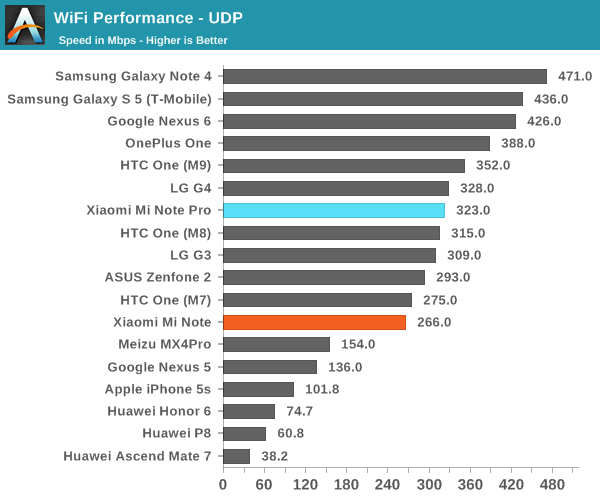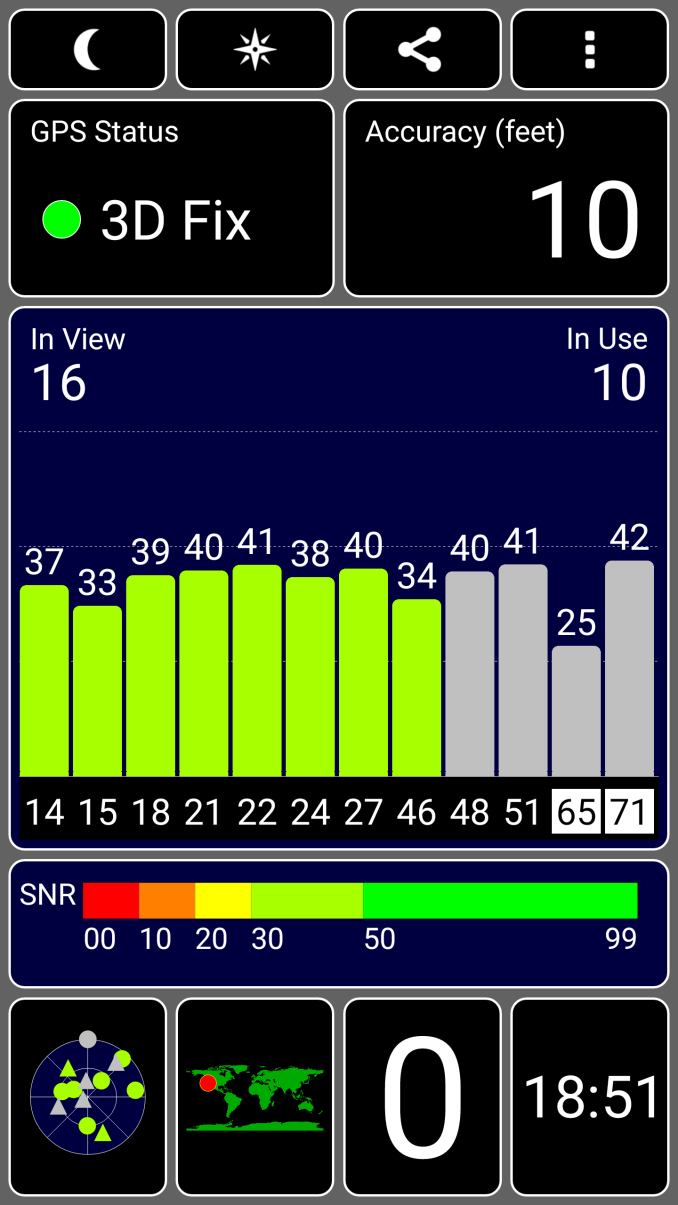The Xiaomi Mi Note Pro and Mi Note Review
by Joshua Ho on September 11, 2015 9:00 AM ESTWiFi Performance
Even though smartphones are usually considered to be necessary for their mobile data capabilities, smartphones and tablets tend to spend a lot of time on WiFi networks instead. As a result, it’s important to have a smartphone with good WiFi connectivity as otherwise there’s potential for poor bandwidth, connection reliability, and frequent drop-outs from a router. Anyone that has tried a smartphone with poor WiFi will probably understand just how frustrating all of these things can be. In order to try and approach testing a complex radio subsystem, we’ve settled for a relatively simple bandwidth test using iPerf to see what the maximum UDP download rate is on the device under test. In the case of the Xiaomi Mi Note, we see a Qualcomm Atheros WCN3680 WiFi chipset, and the Mi Note Pro appears to use a QCA6174 despite only enabling a single spatial stream.

Interestingly, the Mi Note Pro ends up with a higher peak bandwidth result than the Mi Note even though both are using a single spatial stream. I’m not sure what’s causing this, as performance between the two should be relatively as the main performance improvement from QCA6174 should be dual spatial stream 802.11ac. Either way, neither should have significant problems in everyday use of WiFi given dual band support and support for the latest standards.
GNSS
Location services are surprisingly important in a smartphone. Without highly accurate, reliable, and fast location fixes a number of applications in a smartphone would be difficult if not impossible to implement. Turn by turn navigation is easily one of the most common and critical location-based applications a phone will run, and poor GNSS performance is a good way to make sure it never gets used. In order to test this, we run a standard GPS information application and attempt to accurately track just how fast it takes for a phone to acquire a lock without any GPS assistance (airplane mode) and no pre-existing assistance data. In the case of the Xiaomi Mi Note phones, the GNSS solution is likely to be integrated into Qualcomm’s modem, which means that with any kind of mobile data connection time to first lock is on the order of 5 seconds.
Running the test previously described, the Mi Note line appears to achieve first lock in roughly 40 seconds, and almost immediately after first lock is acquired accuracy is at 10 feet. It’s actually quite rare for a phone to achieve this, as most phones usually take at least an extra 10-30 seconds to get down to usable accuracy levels once first lock is achieved. Received signal strength is quite strong with most satellites strongly in the 30 dB SNR range.
Misc
While we don't really have the necessary equipment to do audio right, I noticed a number of things on the Mi Note series that seems to set the Mi Note line apart from other phones I've tested recently in audio performance. The first thing worth noting is that the speaker gets painfully loud, to the point where I usually keep volume under half of the maximum. I normally keep something like the One M8 closer to 75-100% volume, so it's pretty safe to say that these phones can pretty much reach unsafe levels of volume if you want them to. There's also a Saber ES9018 DAC connected to the phone over i2c which is probably used for 3.5mm output, and the speaker's amplifier is driven by Texas Instruments' TAS2552 which can reach a maximum of 4 watts. The touch screen on both appears to be Synaptics' in-cell touch solution if you go by system files, but for some reason the ITO grid is still visible.











94 Comments
View All Comments
valinor89 - Friday, September 11, 2015 - link
Xiamomi is about to start trials with some products in the Us and other countries. You could end up having acces to this phone or its successor before long...Or do like the people who bought those korean screens early on and import.
I live in Europe and most of the products reviewed here are not directly avaiable to me, even less at the same relative price, 1€=1$ over here, but I still like to read about new product tendencies, at the minimun it lets me evaluate the products I can get in another light.
menting - Friday, September 11, 2015 - link
How are phones any ground breaking nowadays? There have been 0 phones in the past few years that are groundbreaking, with maybe the exception of the S6 Edge with the curved screen. And if it's fair to whine about something you can't use, then 1) Verizon/Sprint customers will be whining more than 50% of the time here, and 2) Who said you can't use it? Does the lack of LTE make it unusable? BS.Yaru - Sunday, October 4, 2015 - link
You don't have to care but I very very much do. Not all of their products are only applicable to the US, some of them apply to other countries as well.Also, you can buy a Xiaomi phone from the US. Much like I can buy US phones from here. The iPhone 6+ I'm using to type this comes directly from the US (a T-Mobile to be exact). Just because Xiaomi doesn't sell it directly doesn't mean you can't buy it.
lilmoe - Friday, September 11, 2015 - link
That's the worst thing one could ever do really. You should buy a product that has proper support in your country. Good luck finding parts or repairing the device. And good luck if you get a lemon.mforce - Friday, September 11, 2015 - link
Actually I bought an LG Optimus G made for Korea ( F180L ) which I've flashed with the ROM for E975 but keeping the modem part of the F180L .... I have all the 2G and 3G bands working perfectly here in the EU and the phone has been doign well for 2 years now.It is true that it's a risk you're going to make when buying without a local warranty but the seller might still honor your warranty if you send it back. Also yes you need to carefull look at the supported bands but some might just work out fine and be what you need in your country too.
Xiaomi does make phones which have all the right bands for the EU ( including LTE ) so I'm OK with reading reviews about Xiaomi phones such as this.... this isn't a US only website you know. Maybe folks from China read it too for instance ... Also many Xiaomi phones are available in India where they speak EN so ...
DigitalFreak - Friday, September 11, 2015 - link
You just don't get it. No-one said they shouldn't review non-US phones. Just put a blurb in the beginning saying it doesn't support US bands. Why is that one simple thing so hard for people to comprehend?Pissedoffyouth - Friday, September 11, 2015 - link
>I'd rather not waste my time reading a review of something that's only available in Asia/Europe.Why not? I'm a tech head, I'm happy to read reviews of droids only available on Verizon even though I'm in Europe because its great to see what competition ithere is.
menting - Friday, September 11, 2015 - link
talk about being self-centered! So they'll have to say if it's going to be on Sprint and/or Verizon too I suppose?DigitalFreak - Friday, September 11, 2015 - link
Yeah, because I'm the only person who reads through a review only to find out they won't be able to use the device.BMNify - Friday, September 11, 2015 - link
Anandtech is an International website with only 40% of the readership coming from USA and Xiaomi already caters to the largest smartphones markets that is China, India, Brazil, Taiwan, Singapore, Malaysia and Philippines. So, your redneck 'Murican pride is misplaced here.